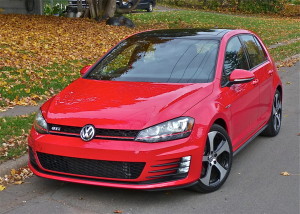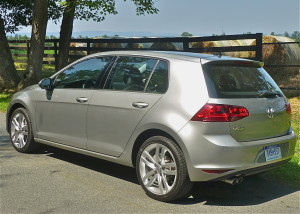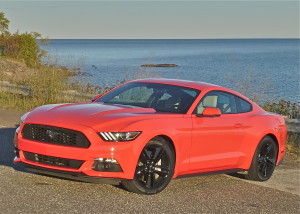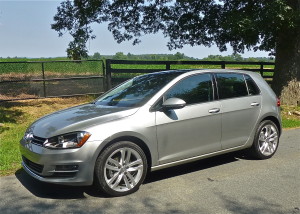New Golf is the Answer; Which One is the Question
Filed under: Weekly test drives, Autos
By John Gilbert
A car-buyer who strolls into a Volkswagen dealership to check on the 2015 Golf compact hatchbacks can be excused for feeling curious, impressed, confused, and overwhelmed — all in the space of several minutes. It’s like attending a dinner party, noting that available entrees includes your favorites, such as steak, pork chops, lamb chops, halibut, walleye, and salmon– and then you realize you have to select only one.
At the VW dealership, examining the Golfs used to be pretty easy. If you were seeking basic transportation you’d pick the base car with that pretty dull but smooth 5-cylinder engine. If you wanted the hot one, you’d pick the GTI with jacked up power, suspension and trim. And if you wanted the ultra-high-mileage version, you chose the TDI turbo-diesel and set off to pursue 50 miles per gallon. For the 2015 model, all versions of the Golf are improved, and with an electric version, a wagon, and a higher high-performance model, the decisions get more confusing but also more rewarding.
First glance may not betray any major change. The car looks pretty much the same, although a discerning eye can detect some rounding off of the squarer corners to streamline the aerodynamics of the boxy vehicle. You can’t tell that it’s mounted on VW’s new MQB platform, which will underpin all VW sedan models and a few Audis as well, and sits an inch lower, 2 inches longer and a bit wider than the 2014 Golf. Or that the new car is built of 80-percent high-grade steel, making it lighter and with an obvious improvement in torsional rigidity.
That squarish 4-door shape houses 52.7 cubic feet of interior room, an increase over the 2014 model, and more than many midsize cars. Inside, the appearance is mostly black in, with a little satin-finish trim here and there. Pleasant and straightforward, something that will be prized by those, like me, who have grown weary of fake woodgrain and/or bright chrome-like trim that gathers reflections and driver’s-eye distractions.
It’s understandable that the top models, such as the GTI and TDI, might have neat interiors, but perhaps most impressive is the base car with the new TSI turbocharged 4. Not only does it have nicely bolstered bucket seats, and the soft-touch material on its no-frills dashboard, but it also has a 5-speed stick shift in basic form, and you only miss the preferred 6-speed until you live with the 5-speed and its wide-ratio ease of operation. Read more
Mustang, Golf, Genesis are Car of Year Finalists
Filed under: Weekly test drives, Autos
Much like the college football season, the nation’s top automotive journalists have finished the “regular season” of evaluating the newest 2015 cars and truck/utility vehicles, and now the focus is on choosing the “national champions.” The Volkswagen Golf, Ford Mustang, and Hyundai Genesis are the three finalists for 2015 North American Car of the Year, selected after each of 57 jurors distributed 25 points among their choices.
The top three vote-getting vehicles for North American Truck/Utility of the Year are the Ford F-150, the Lincoln MKC, and the Chevrolet Colorado.
Having earlier voted to cut the field of all-new or thoroughly redesigned vehicles down to 10 or 12, jury members voted to determine the top three, with a maximum of 10 points allowed to one, and only one, in each category and all 25 points required to be distributed. That vote determined the top three, which were revealed December 8 in Detroit.
After a mad scramble to drive and evaluate all the cars on the original and shortened lists, the jury members (including this writer) next reevaluate the three finalists in both categories, then distribute 10 points, which are compiled to determine both the 2015 North American Car of the Year and the North American Truck/Utility of the Year. The winners will be named at the Detroit International Auto Show on January 12, preceding the show’s first media preview day.
Ford Motor Company, with the Mustang and the F-150 and MKC, stands as the only one with a chance to duplicate the 2014 sweep by Chevrolet, which won both awards with the Chevrolet Corvette and the Chevrolet Silverado. Ford’s Mustang has been completely redesigned, adding independent rear suspension, and offering a new EcoBoost 2.3-liter 4-cylinder engine to join the 5.0 V8 and the 3.7-liter V6 and the 5.0-liter V8. Prices range from $25,000-$50,000, with all three engines delivering over 300 horsepower in the rear-drive coupe.
Volkswagen’s seventh-generation Golf retains its familiar boxy shape, but has several significant upgrades to its front-wheel-drive package in a variety of models that cover the compact segment as well as its price range ($20,000-$35,000). VW’s impressive new 1.8-liter turbocharged 4 replaces the boring and unloved 5-cylinder with more power and better fuel economy. Included in the Golf family is the TDI — turbo-diesel — which is a newly revised version of the already world-class 2.0-liter 4-cylinder diesel and can approach 50 miles per gallon. On top of those models is the GTI, a sporty version with the 2.0-liter turbo gas engine that has sportier suspension, wheels, tires, seats and interior appointments. Read more






 John Gilbert is a lifetime Minnesotan and career journalist, specializing in cars and sports during and since spending 30 years at the Minneapolis Tribune, now the Star Tribune. More recently, he has continued translating the high-tech world of autos and sharing his passionate insights as a freelance writer/photographer/broadcaster. A member of the prestigious North American Car and Truck of the Year jury since 1993. John can be heard Monday-Friday from 9-11am on 610 KDAL(www.kdal610.com) on the "John Gilbert Show," and writes a column in the Duluth Reader.
John Gilbert is a lifetime Minnesotan and career journalist, specializing in cars and sports during and since spending 30 years at the Minneapolis Tribune, now the Star Tribune. More recently, he has continued translating the high-tech world of autos and sharing his passionate insights as a freelance writer/photographer/broadcaster. A member of the prestigious North American Car and Truck of the Year jury since 1993. John can be heard Monday-Friday from 9-11am on 610 KDAL(www.kdal610.com) on the "John Gilbert Show," and writes a column in the Duluth Reader.